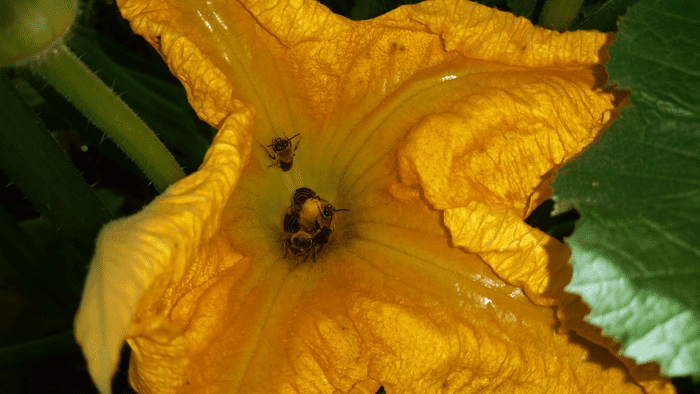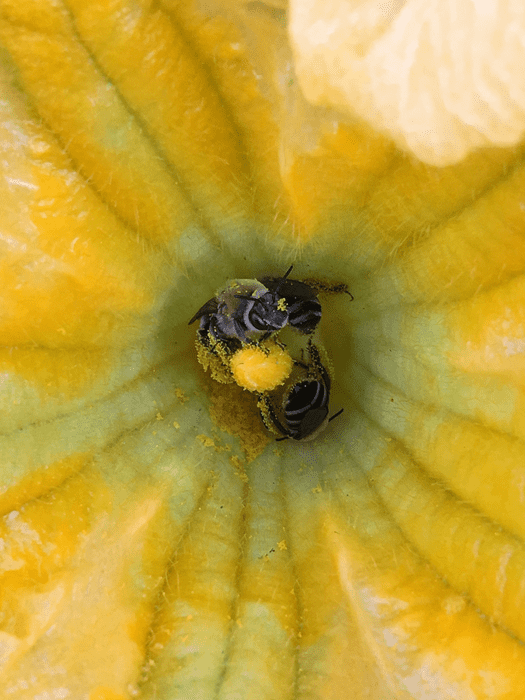Wild fields are typically messy, diverse, and filled with different plants and insects. Agricultural fields are neat, ordered and, from a biodiversity standpoint, almost barren. Agriculture, and intensive agriculture in particular, can be devastating for local insect populations, and as a result, pollinators all around the world are struggling and populations are plummeting. But one bee is doing just fine. Its secret? A passion for pumpkins, zucchinis, and other squashes.

Without pollinators and pollination, the world as we know it couldn’t exist. We need pollinators for much of our agriculture, and pollinators such as bees provide unpaid labor that feeds billions and provides around $500 billion per year in benefits. But we don’t really treat pollinators right.
Over the past 15 years, bee colonies have been disappearing as a result of what is called “colony collapse disorder”. Colony collapse disorder is still poorly understood, but research suggests that things like pesticides, pollution, and intensive agriculture are some of the main drivers behind it. Other insects, like flies, have adapted much better, but bees are struggling — with one exception, a new study reports. A type of bee commonly referred to as the “squash bee” (Eucera pruinosa) seems to be doing just fine.
“When we think of insects benefiting from and adapting to widespread agriculture, we tend to think of pests such as certain kinds of moths, flies and beetles,” said Margarita López-Uribe, Lorenzo L. Langstroth Early Career Professor and Associate Professor of Entomology. “But the impact of agricultural intensification on the evolution of beneficial pollinators is poorly understood. We found that agriculture facilitated increases in population size of this squash bee, and this may be the case for other insect pollinators, as well.”

As the name implies, squash bees like squashes. They’re spread across North America from the East Coast of the United States to the West Coast and to Mexico. The study only focused on North America. Without a closer look, the squash bee looks fairly similar to a honeybee, but unlike the honeybee, the squash bee has increased its range. The squash has long been an important crop in North America, being grown by Indigenous populations for over 5,000 years. But in the past centuries, the growth of the bees’ favorite plants has increased dramatically.
“By planting squash all over North America, humans created habitat for the squash bee, and that allowed its population to explode,” said López-Uribe. “Today, the squash bee occurs throughout the United States and southeastern Canada — far beyond the range of its original food source.”
To get a closer look at how the bee changed and adapted to the new conditions, researchers sequenced its genome and examined the genetic diversity within different bee populations, looking for tell-tale signs of adaptation. For instance, when there’s a lower genetic diversity, it can be indicative of “selective sweeps” — a process through which a new beneficial mutation increases in frequency and becomes very common or ubiquitous in a population. The team then developed an algorithm that used the available information to estimate how the squash bees migrated and changed their population size in different populations.
They found that nearly 20% of the bees’ genome appears to be linked to selective sweeps during which bees transitioned from wild host plants to agricultural habitats. In particular, they found genetic changes linked to chemosensations — the translation of chemical signals to neurological signals. For bees, chemosensation plays a key role in the ability to analyze flowers. For squash bees, this showed signs of changing the focal interest from wild plants to agricultural plants.
“Domesticated Cucurbita plants produce floral blends that are simpler than those of the wild Cucurbita plant,” said López-Uribe. “It is likely that E. pruinosa adapted to a new sensory environment in agricultural habitats, which enabled it to expand its range and significantly increase its population size.”
This doesn’t mean that suddenly, intensive agriculture is good for pollinators. The opposite has never been more true, in fact. But it does mean that a minority of pollinators can adapt to the new conditions — and may even thrive.
“These results suggest that the widespread cultivation of crops can prompt adaptation in wild pollinators through the distinct ecological conditions imposed by agricultural environments,” the study authors conclude.
The study was published in PNAS.









